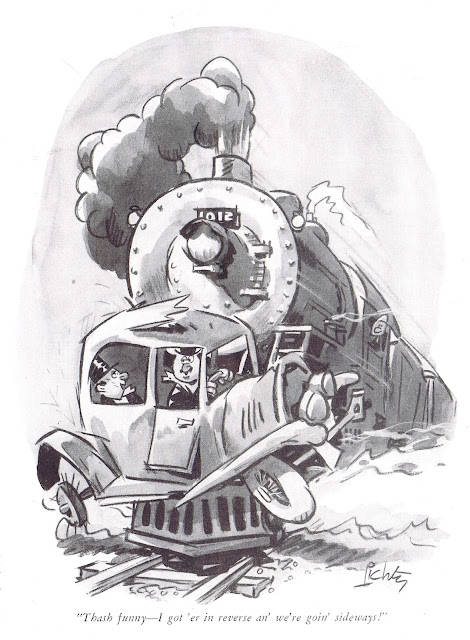Dick Buchanan has delved into his personal collection of magazine
cartoons to come up with an exclusive look at the great cartoonists of
the 1930s. There are many familiar names here: Dr. Seuss,
Charles
Addams, Marge, Jack Cole, Chon Day and others. What's of interest is
that there are certain cartoonists who were best known for other
work, and here they are drawing gag cartoons. Cartoonists like Jack Cole who may be best known for his Plastic
Man comic book or the Playboy cartoons he would create 20 years later.
Or Dr. Seuss, who is best known for his children's books. It comes as a surprise to
see them, selling single panel cartoons to the old Life magazine or
Judge.
Thanks, Dick, for putting this together. Some amazing stuff here! Take it away:
---
GAG CARTOONS OF THE 1930’s
1930 - 1939
The 1930’s were tumultuous times, beginning with Prohibition, Repeal,
Franklin D. Roosevelt, the Dust Bowl and the beginning of World War II.
But it was also an important time in the development of the gag cartoon
as we know it today.
From the 1800’s until the late 1920’s most cartoons contained a title
above the cartoon and captions noting the identity of the speakers.
Captions were divided into two lines -- one for the setup, with the
second line delivering the humor. Most cartoons in those days were
masterfully executed illustrated jokes.
Although there were a few single caption cartoons in the early days, it
was their appearance The New Yorker in 1925 changed everything. They
took the lead in creating the format of the “modern” cartoon. By the end
of the 1930’s the single panel cartoon had evolved into gag cartoon as
we know it today.
The 1930’s also saw the debut of the many great cartoonists who were to
dominate cartoon world for many decades. Several have been included in
this collection. Some had hit their stride style-wise while others were
yet to develop their familiar styles.
This was the age when
cartoonists worked with brush, ink and ink wash over graphite under
writing on thick ¼” illustration board.
Here from the dusty shelves of
the Clip File Library are some examples of cartoons as they were long,
long ago.

This spectacular Life cover by Dr. Seuss (Theodor Geisel) was
one of his best. In addition, it contains the germ of an idea that well
may have inspired my childhood favorite book, Horton Hatches the Egg.
Life May 1934.
1. GARDNER REA. Judge October 11, 1930.
"At that, sir, you hadn't oughta trumped her ace."
2. BILL HOLMAN. King of the screwball cartoonists, Holman’s Smokey
Stover would debut in 1935. The New Yorker’s George Booth inserts a dog
in many of his great cartoons. Holman also used this device with a
mischievous cat appearing in many of his cartoons. This cat, later known
as Spooky, earned his own comic strip. Life September 11, 1931.
"Good Lord! That d--n cat again!"
3.
GLUYAS WILLIAMS. One of the foremost cartoonists and illustrators,
Williams' work was a fixture in the early New Yorker. He illustrated many
of Robert Benchley’s hilarious books. Life September 11,1931.
4.
ERNIE BUSHMILLER. Although his comic strip Fritzi Ritz had been running
since 1922 (Larry Whittington was the creator; Bushmiller took it over
three years later), occasionally his work appeared in Judge. Nancy first
appeared as Fritzi’s niece in 1933. The strip was retitled Nancy in
1938.
Judge June 1932.
5. GEORGE LICHTY. Lichty was best known for the
long running panel cartoon Grin and Bear It. Life August 1933.
"Thash funny -- I got 'et in reverse an' we're goin' sideways!"
6.
WHITNEY DARROW, Jr. Darrow’s familiar style was in it’s formative stage.
Judge June 1934.
7. CHON DAY. Judge June 1934.
8. RICHARD
DECKER. Superb drawing by Decker, as always. Life March 1935.
8. NED
HILTON. Another New Yorker favorite for decades, Hilton often had
several drawings in each issue. Life March 1935.
"Abercrombie and Fitch are wondering about their little bill."
9. MARGE. Marjorie
Henderson Buell creator Little Lulu began as a gag cartoonist. Life
March 1935.
10. MARGE. Little Lulu replaced Henry as the featured
panel on the last pages of the magazine, the spot would later be
occupied by Ted Key’s Hazel. The Saturday Evening Post February 5, 1938.
11. GEORGE SHELLHASE. Life August 1935.
12. DOROTHY McKAY. Life
August 1935
13. CHARLES ADDAMS. Addams rarely strayed from the pages
of The New Yorker, but drawings appeared occasionally in True and
Collier’s in the 1930’s and ‘40’s. Collier’s January 15,1938.
15.
JACK COLE. Cole struggled as a freelance cartoonist but struck gold when
he created the memorable comic book hero Plastic Man. Judge, July 1938.
16. LEONARD DOVE. Collier’s January 15, 1938.
17. SYD HOFF.
Judge, 1938.
18. OTTO SOGLOW. Collier’s January 8, 1938.
19.
WILLIAM STEIG. Steig was a favorite of Cartoon Editor Gurney Williams
and often appeared both Collier’s and later Look. Collier’s January 7,
1939.
-- This has been an edited version of a May 3, 2018 blog entry.











































%201963%20Learn%20English%20with%20WALTER%20and%20CONNIE%20English%20By%20Television%20BBC%20Archive%20-%20YouTube.png)






